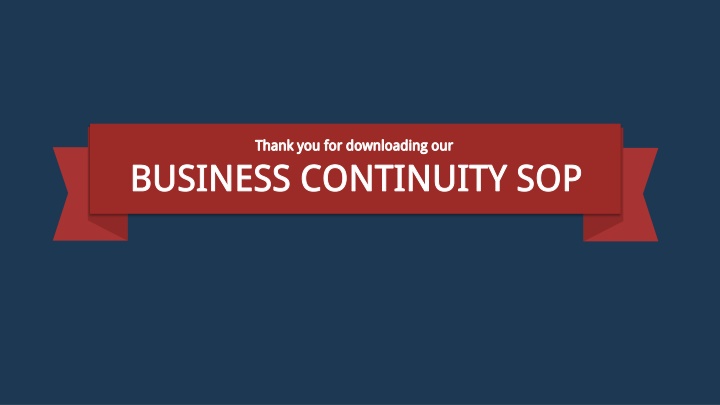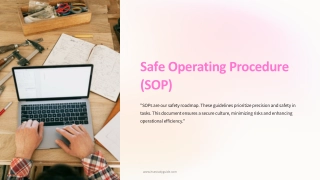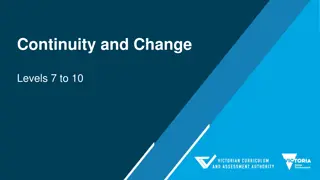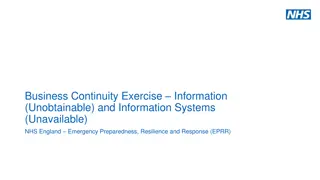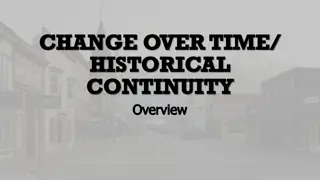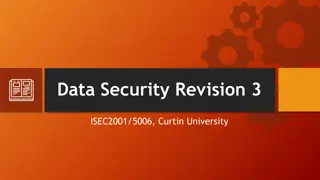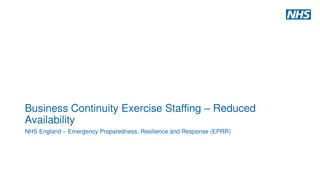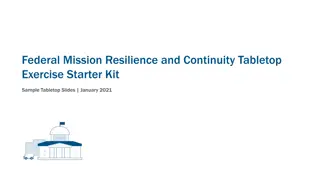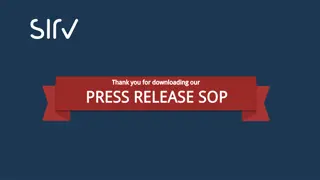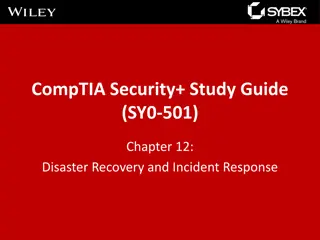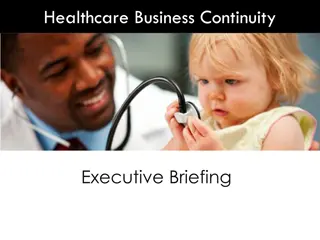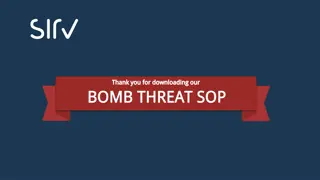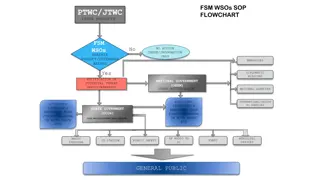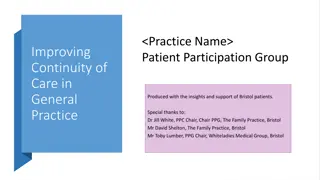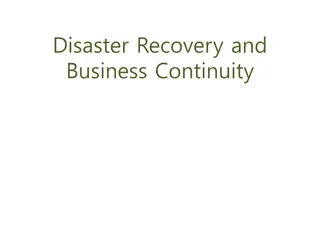Business Continuity SOP and User Guide Overview
This document provides an overview of the Business Continuity Standard Operating Procedures (SOP) and User Guide, aimed at assisting individuals in handling crises effectively. It includes sections on immediate response, review agendas, press release, staff briefing, and specific guidance on handling crises such as kidnap/extortion situations. The User Guide offers tips on adapting the SOP to your organization swiftly. The content emphasizes the importance of proactive crisis management and strategic decision-making in maintaining business continuity.
Download Presentation

Please find below an Image/Link to download the presentation.
The content on the website is provided AS IS for your information and personal use only. It may not be sold, licensed, or shared on other websites without obtaining consent from the author.If you encounter any issues during the download, it is possible that the publisher has removed the file from their server.
You are allowed to download the files provided on this website for personal or commercial use, subject to the condition that they are used lawfully. All files are the property of their respective owners.
The content on the website is provided AS IS for your information and personal use only. It may not be sold, licensed, or shared on other websites without obtaining consent from the author.
E N D
Presentation Transcript
Thank you for downloading our BUSINESS CONTINUITY SOP
Because people are lazy getsirv.com
CONTENTS Introduction Business Continuity SOP About SIRV Disclaimer
INTRODUCTION Working with our community we ve put together some SOPs for you to use, free of charge. The SOPs are designed to be read by the individual on the ground and follow the format used by our decision support system, a decision tree that asks one question and provides one or more answers and instructions.
USER GUIDE This SOP is quite lengthy. If you wish to adapt it quickly then you can do two things: Switch the name in the SOP to your organisation s name by doing find and replace (Edit>Find>Replace) for the following term: [YOUR ORGANISATION] 2) Perform a find and replace in areas that have the term: [XXX] Here you need to add specific information that will be clear from the page you re on.
SOP CONTENTS Page Immediate Response 1 - 9 10 18 Initial Review Agenda 19 28 Secondary Review Agenda 28 40 Press Release 41 - 44 Staff Briefing
Page 1 Question: Does the crisis meet one of the following criteria? Major disruption to services Significant financial impact on organisation profits Major health and safety incident Significant damage to reputation Major regulatory breach National / International media involvement Fraud Go to page 6 Kidnap / Extortion Go to page 2
Page 2: Advice Kidnap / Extortion A threat to injure or kill personnel, damage goods or property or reveal information that could be damaging to your organisation s reputation or a senior member of management. UK Contact Inform local Police force (999). The Police have contingency plans for dealing with such events. Overseas Contact Identify the correct local law enforcement agency for extortion crimes Decide on the policy with liaising with the agency and instruct local staff how to act Decide the degree of liaison with local government agencies Assess the agency's ability and experience in dealing with such crimes CONT ..
Page 3: Advice Kidnap / Extortion Considerations It is important to carry out a detailed assessment of any approach: Identify the target [YOUR ORGANISATION] or a member of staff Motive, capability and likely intentions of the perpetrator(s) Reality and credibility of the threat Detailed analysis of the threat: To kill, kidnap or injure personnel To sabotage, damage or steal equipment or property To damage the reputation of [YOUR ORGANISATION] or an employee Implications to [YOUR ORGANISATION] if the threat is carried out [YOUR ORGANISATION] ability to protect against, deflect the threat in both short & long term Information about any other existing or previous similar threats and their outcome Legal implications of conceding to demands The time available before a response has to be made CONT ..
Page 4: Advice Kidnap / Extortion Options Open Following your assessment of the situation, decide what action to take. The options are: 1. To ignore the approach in order to test the seriousness of the extortionist 2. To make a response, indicating that [YOUR ORGANISATION] are willing to enter into a dialogue, but are not willing to concede to demands immediately 3. To signal to the extortionist that [YOUR ORGANISATION] are willing to concede to demands Administration Start an events log, noting developments, issues raised and decisions taken Ensure all documents are treated confidentially and stored securely Keep all originals for use in the event of court proceedings Ensure that the incident is not discussed with unauthorised personnel If applicable, contact insurers as specific insurance cover has been contracted CONT ..
Page 5: Advice Kidnap / Extortion Media Prepare holding statement for any enquiries Decide media spokesperson and policy in the event that the incident becomes public knowledge Security Review existing security measures Identify if any additional measures can be introduced to prevent the threats being carried out Decide whether to call in specialist consultants
Page 6 Select an option: Rendezvous location - go to page 7 Contact Details - go to page 8 Resource Requirement - go to page 9 Continue to Initial Review Agenda - go to page 10
Page 7: Advice Rendezvous Location Where people should rendezvous: [XXX]
Page 8: Advice Contact Details Who people should contact: [XXX]
Page 9: Advice Resources Following items should be sourced: PC's/Laptops/Tablets E-mail & Internet access Fax & Direct phone lines Conference Call facility Whiteboards/Flip Carts TV Stationery
Page 10 Initial Review Agenda Impact Analysis to to page 11 Organisation objectives to to page 12 Communication to to page 13 Legal to to page 14 Insurance to to page 15 Media & Information to to page 16 Project Information to to page 17 Secondary Review Agenda: Next steps to to page 18
Page 11: Advice Impact Analysis What has happened? What do we know? What is the scope of the problem? What are the implications? Is there more to come? Is this a threat to reputation? What is the worse case?
Page 11: Advice Organisation Objectives What are the organisation objectives? Define & prioritise What are the timescales How long will the crisis run?
Page 13: Advice Communicatio n Who should we tell? Define and prioritise What is the 'core message'? Determination of any external bodies to be notified Determination of any internal communications that need to take place (Business Unit MDs, Owners, employees etc.)
Page 14: Advice Legal What legal action is required?
Page 15: Advice Insurance Is insurance cover available, and if so, how best to use the support it may provide?
Page 16: Advice Media Information Media strategy to be implemented: What is the story? What is the deadline? Identification of major information gaps. Development of an investigative strategy.
Page 17: Advice Project Management Actions required when? Specialist advisors required? Who to put on standby? What assistance could we provide immediately to the site/people affected by the crisis? Resources for the team - staff, meeting schedule.
Page 18: Advice Checklist Initial Review Agenda No. 1 Review Checklist Ensure you have considered all the following?: Command centre established IT support on site Business area staff at recovery site(s) Business area staff at other agreed site(s) Key IT systems etc. up and running Insurance contacted Communications to all staff Continue Secondary Review Agenda page 19
Page 19 Secondary Review Agenda Legal go to page 20 Reputation go to page 23 Organisation Objectives go to page 27 Communication: Press Release go to page 29 Communication: Staff Briefing go to page 41
Page 20 Legal A legal perspective is designed to protect: The organisation from criminal prosecution The organisation from future liability Officers and employees The organisation position with insurers and regulators Documents There may be a requirement for the advice on: A protocol on documentation for the all those involved in the management of the crisis - 'legal advice privilege' and 'litigation privilege' Advice on press releases Liability Legal duties of Directors Making notifications to external regulators and prosecutors CONT ..
Page 21 Legal There may be a requirement for the advice on: Breach of contract The implications on Governance standards for a proposed course of action Conflicts of interest within stakeholders (could be between directors, shareholders, employees, professional advisors and bankers). Investigate Strategies: What options exist for internal enquiry exist? Criminal or civil? 3 primary issues: Confirmation of the identity of the internal (if appropriate) and external target Identification of the nature, quality and quantity of evidence required to achieve objectives A determination of how evidence to be gathered - sources CONT ..
Page 22 Legal Also consider: Compensation options including 'ex-gratia' payments Advice on the legal positions should employees leave the organisation during crisis Positions on defamatory press coverage Fraud Handling of any witnesses Advice on any course of action that involves litigation and outlining the potential implications for the organisation and Crisis Team The use of litigation as a tool - civil remedies - Orders Advice on timescales of legal process/possible actions
Page 23 Reputation Analysis of impact: What has happened? Could this call into question the reputation of the organisation, the group or the industry? Does it question our health and safety standards/record in this area? Is this an isolated incident - has this happened before - is there more to come? Is there anyone else (culpably) involved ? What is the worse case - how bad could it get? CONT ..
Page 24 Reputation Organisation Objectives: What are the organisation s objectives? Define and prioritise: Containment - can the crisis be contained - how can we put a cap on speculation and publicity? Refer to the geographical name of the location What are the timescales? How long will the crisis run? CONT ..
Page 25 Reputation Communications: What timescales are relevant? TV/Radio Print: daily, weekly Internet International wake-up time Is our holding statement sufficient? What are our audiences going to make of it? Segment and Define if not already done - prioritise communication Investor relations How quick and when can communication be established? Who are our allies - who could help us with the message? And delivery (trade associations, HSE, MPs etc) CONT ..
Page 26 Reputation Project Management Actions required when? Specialist advisors required? What assistance could we provide immediately to the site/people affected by the crisis to assist reputation management?
Page 27 Organisation Objectives Organisation crisis management objectives will vary according to the type of crisis. Remember the stated objectives of this plan: To save life To prevent the crisis/disaster escalating To relieve suffering (public, staff and relatives) To safeguard the environment To protect the reputation of [YOUR ORGANISATION] To minimise any significant potential loss of revenue to [YOUR ORGANISATION] To protect property To facilitate criminal investigation and judicial, public, technical or other inquiries To recover the business and restore normality as soon as possible When the team is invoked, these objectives need to be addressed in the light of the crisis event CONT ..
Page 28 Organisation Objectives Organisation crisis management objectives will vary according to the type of crisis. Remember the stated objectives of this plan: To save life To prevent the crisis/disaster escalating To relieve suffering (public, staff and relatives) To safeguard the environment To protect the reputation of [YOUR ORGANISATION] To minimise any significant potential loss of revenue to [YOUR ORGANISATION] To protect property To facilitate criminal investigation and judicial, public, technical or other inquiries To recover the business and restore normality as soon as possible When the team is invoked, these objectives need to be addressed in the light of the crisis event
Page 29 Press Release Ideally only staff that have been media trained should manage media releases. If you re not media trained limit your focus on the facts.
Page 30 Press Release Expect the following questions: 1. What happened? 2. How did it happen? 3. When and where did it happen? 4. Why did it happen? 5. Who is to blame? 6. What are you going to do about it? (how will you stop it happening again) CONT ..
Page 31 Press Release The media will expect you to address issues in the following order of priorities: 1. People 2. Environment 3. Property 4. Money CONT ..
Page 32 Press Release In Advance: Find out what the media deadlines are and manage expectations around them. Control events by issuing statements / interviews to according to your schedule. Should an impromptu interview be requested try and delay it to fit in with your schedule, if you accept the interview ensure you find out what are the requirements of the interview. Establish the known consequences Confirm what [YOUR ORGANISATION] is doing to remedy the situation Establish what [YOUR ORGANISATION] can say about developments CONT ..
Page 33 Press Release On first encounter with someone from the media find out: What the they understand has happened Seek to understand why they re going to ask you questions Prepare the three key points you want to say Prepare for the three questions you do not want to be asked CONT ..
Page 34 Press Release Do: Record what you say Bring in expert advise if necessary Display concern care about what has happened and be sympathetic Display commitment - to find out what happened and put it right Display control of the situation at the most senior level Be available and co-operative Be positive and truthful CONT ..
Page 35 Press Release Don t: Admit liability Give graphic descriptions Refuse to answer any questions Blame another organisation for difficulties Repeat negative or inflammatory words used by a reporter CONT ..
Page 36 Press Release Don t Forget: Do not speculate, focus on the facts Manage and control the release of information Consistency of response from [YOUR ORGANISAITON] is critical CONT ..
Page 37 Template Letter [YOUR ORGANISATION] is sorry to say its business at [LOCATIONS EFFECTED] has been: Temporarily closed because of [INCIDENT] [OR] Closed for the foreseeable future due to a [INCIDENT] ......... [OR] Suspended because of [INCIDENT] ..................[OR] Other The incident began [TIME] on [MONTH] [YEAR] CONT ..
Page 38 Template Letter There have been no injuries/fatalities [OR] There have been injuries/fatalities totalling [NUMBER] The Police / authorities / H&S Executive are investigating the cause of the incident with the full co-operation of the organisation. We are implementing a business recovery plan and are contacting: CONT ..
Page 39 Template Letter Our Employees Employees will be contacted by their Manager, if they re not contacted within [X] hours they should call the number below. Relatives and Friends of Employees If you have any concerns, please call [X] Customers and Suppliers If you have any concerns, please call [X] CONT ..
Page 40 Template Letter [YOUR ORGANISATION] has a business resilience plan and it has been invoked. Contact can be made at .................................................. Tel ................................ from ..........am/pm on .......................... A further announcement will be made as soon as possible. CONT ..
